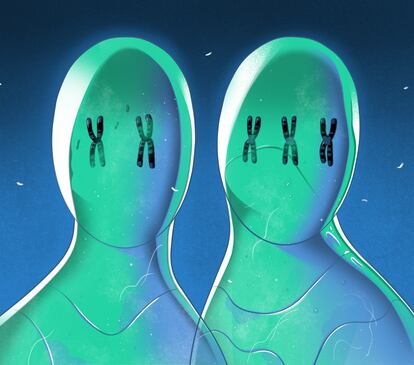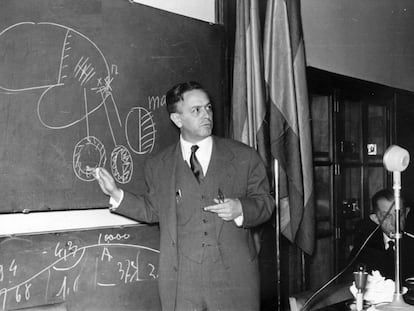Don’t call it Down syndrome
To overcome the bias of past scientists, the name by which chromosome 21 trisomy is popularly known should be changed

No machine, whether natural or artificial, is perfect. During the formation of human germ cells (sperm or egg cells), the two copies of the genome that we have in all cells become just one in a process called meiosis. In our cells, the genome, which represents all our genetic material, is found in structures called chromosomes, which are easily visible under a microscope. When the two germ cells join to form an embryo, the embryo has two copies of each chromosome again, but half come from the father and half from the mother.
Sometimes the process fails and one of the germ cells is left with two copies of the chromosome or none at all. When such an embryo is formed, it has either one chromosome too many (trisomy) or one chromosome too few (monosomy). In most cases, this alteration is fatal, and the embryo is unable to develop, which is why trisomies or monosomies have not been described for all chromosomes; in theory, these defects could occur in any of them. In other cases, however, the pregnancy can be carried to term, although the patient who suffers from these defects may present certain symptoms.
Sex chromosomes are some of the ones affected by chromosome number alterations. The presence of two X chromosomes determines a female, while the presence of XY chromosomes determines a male; but there are also situations of monosomy of the X chromosome (Turner syndrome) and of trisomies XYY (double Y syndrome), XXX (triple X syndrome) and XXY (Klinefelter syndrome). Based on evidence in art and in the descriptions of his contemporaries, it seems that Charles II. Archduke of Austria, also known as Charles the Mad, might have suffered from Klinefelter syndrome.
Among the numerical alterations that affect the non-sex chromosomes, there are descriptions of monosomy of chromosome 21, trisomy of chromosome 22, trisomy of chromosome 18 (Edwards syndrome), trisomy of chromosome 13 (Patau syndrome) and the best known and most common, trisomy of chromosome 21, popularly known as Down syndrome. The latter is one of the few alterations that do not affect the sex chromosomes and allow an individual to develop and reach adulthood.
It is likely that this syndrome has been known since antiquity because of its relatively high occurrence. The oldest clinical description dates from 1838 and is attributed to French physician Jean-Étienne Esquirol (1772-1840). In 1846, the Frenchman Édouard Séguin (1812-1880) described the syndrome and called it furfuraceous idiocy. At that time, the generic medical term for any type of mental disability was “idiot.” The adjective “furfuraceous” — resembling bran — refers to the flaking skin that many persons with this condition have.
When the first clinical descriptions were released, scientific observation was intermingled with a scientist’s ideological bias. During the 19th century, presumably scientific theories that established the white race’s moral and biological superiority were common. These theories sought to justify slavery or colonialism on biological grounds. Rudyard Kipling’s poem The White Man’s Burden reflected these biases.
Influenced by these ideas, in 1866, physician John Langdon Down (1828-1896) classified mental dysfunctions based on racial criteria; according to this theory, the mentally ill could be classified as Ethiopians, Malays, Americans, Caucasians or Mongoloids. This openly racist characterization, which seems embarrassing today, was probably also influenced by some misunderstood Darwinian concept and the theory at that time that many mental problems could be explained as evolutionary regressions. Thus, scientists argued that the white European race was the pinnacle of evolution, and mental illnesses were setbacks in an evolutionary process in which the mentally ill had fallen to less evolved stages. According to that line of thought, the mentally ill were categorized as different “inferior” races. The point is that this classification scheme — influenced by the racial bias of the time but without a scientific basis — was the one that prevailed. Words like “mongoloid” and “Down syndrome” have long since entered everyday language to describe chromosome 21 trisomy. These terms are grossly unfair because Down was not the first to describe the syndrome, nor does the syndrome have anything to do with Mongolia.
Historical and medical memory
Changing names because of changing social circumstances also occurs in medicine. In 1961, 16 physicians, including a direct descendant of Dr. Down, signed a letter addressed to the medical journal The Lancet in which they requested the elimination of the terms “mongoloid idiocy,” “mongolism” and “mongoloid” and their derivatives from the medical vocabulary. Among other alternatives, the letter suggested renaming it Down syndrome. But the most correct and least offensive term for the syndrome for patients and their relatives would be “trisomy 21.″
J. M. Mulet is Professor of Biotechnology.
Sign up for our weekly newsletter to get more English-language news coverage from EL PAÍS USA Edition









































